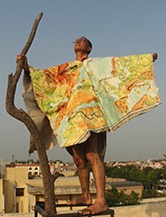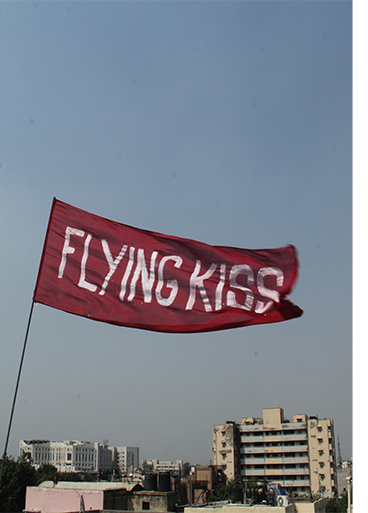Art and the Pandemic: Some Reflections
- Ranjan Kaul

- Jun 25, 2021
- 7 min read
by Ranjan Kaul
Since the onset of Covid-19 many visual artists and gallerists have been lamenting about how the pandemic has wrought havoc on the art community. For the large majority of artists, it has been a struggle to survive, with galleries forced to down their shutters (there have been many that have been compelled to close shop for good) and buying art sitting at the bottom of the pyramid of buyers’ priorities. Although there have been digital shows and virtual auctions, these have been poor substitutes and have not greatly benefitted the majority of artists; only a few privileged artists have continued to thrive. According to senior artist Arpana Caur, “Collectors have been offloading most works (except those of the masters) for very low prices.” The situation is grim.

Arpana Caur in her studio in better times
There are several reasons for this but it’ll suffice to mention only one. Quite a few well-heeled art collectors would visit exhibitions because they were occasions to party and drink cocktails and blow air kisses. Buying art was always incidental. The situation is not unique to India; based on her experience, Russian artist Victoria Lomasko surmised, “The collectors for whom the social life around art was more important than the art are buying less.”

Permalockdown, 2020, Victoria Lomasko, The Horst Janssen Museum, Oldenburg, Germany,
photo © Horst-Janssen-Museum
Fake news has been a regular feature of late, but fake art has been around for generations, with fake reproductions of masters or works made in their style passed off as the original. This was blatant forgery and cheating, but in contemporary times, especially in India, there has been another worrying kind of passing off. Gallerists and interior designers have been known to commission artists to paint in the particular style of a famous artist or on a specific theme based on the fancies of for a particular client. Only a few perceptive and informed gallerists have risked promoting artists for their creativity and merit.
For those unfamiliar with the art market in India, a quick background would be useful. Royal and religious patronage over the years shifted to patronage of these galleries and the wealthy clients they served. There were relatively few galleries in the country till the 1990s, but thereafter, seeing the success of the galleries who'd set up shop and growing interest in art, several galleries mushroomed in urban metropolises. These galleries now actively looked for new and emerging artists and became platforms that afforded opportunities to them. We then saw a short period of the art boom in 2006-07 where art became a business as any other and corporate professionals and industrialists started investing in art as they did in the stock market. While the galleries became purveyors of art, these wealthy patrons happily relied on the endorsements of so-called art critics and self-anointed art connoisseurs, with most of them oblivious to the fact that these supposed experts had been sweetly paid by the galleries to write poetic eulogies on the works of the artists they displayed. To cater to such undiscerning collectors and investors of art, we saw another type of “passing off” of fake, decorative paintings of pretty landscapes, Ganesha and Kali and the Buddha, and expressionless abstracts as great art.
I hasten to clarify that while I personally do not paint abstract works, I’ve great admiration for those who create them successfully. I do believe that abstract painting is the most difficult thing to do; like music, one can learn to play an instrument and the keys and notes, but without the requisite talent, the end result may just not be music. Unfortunately, in the majority of cases what gets peddled as art is at best decorative or entertainment, comparable to a woven rug or a beautiful artefact or for that matter a Bollywood song and dance routine and completely disconnected from societal or humanist concerns.
As an aside, today, ironically, in the troubled times we are living in, where any form of criticism or dissent is frowned upon by the “state”, many of these very gallerists who once encouraged emerging artists who were exploring different themes, have now become censorious and cautious, reluctant to accommodate artists who choose to paint themes that may be perceived to be critical of controversial social practices or the “state”.
Artists who hitherto thrived catering to the demands of gallerists, interior designers and their elite clientele have been hit hard because some of these clientele like hotels have been shut down or do not have surplus funds to invest in art. It is difficult to say where these artists have gone, but it’d be no surprise if they’ve moved bag and baggage to another profession. Unlike those who fall prey to market demands, there have been some artists who pursue their passions relentlessly come hell or high water (or even the pandemic).
Internationally acclaimed performance artist Inder Salim, who uses his body to create art, talked about his own experience and how, paradoxically, Covid “has been an extremely pragmatic period; it enabled me to get to know and better understand the body-and-art process. ”When due to the lockdown he could not perform his art in public spaces, he started flying flags."
Flying Flags on the terrace, Inder Salim
Confined within the four walls of the home/studio, like Inder Salim, artists have had the luxury of time to think and introspect on their art and the direction they want to take it in. Artist and curator Rajan Shripad Fulari was of the view that in these pandemic times “thought and expression of the self has become the sole maxim of the artist’s visual language.” Of course, the pandemic has also triggered social art concerning the impact of Covid – for instance, quite a few artists have recently portrayed the plight of migrant workers, untimely deaths, and few more courageous ones, the poor handling of the pandemic. In an earlier article, Kissing a History of Death and Devastation, I’d mentioned how artists throughout history had responded to similar events such as the Spanish Flu and the Black Death. In India too, great art emerged during catastrophic times such as the Bengal Famine and the Partition.
Apart from those connected with galleries who have tried selling art through virtual art exhibitions, the majority of artists have taken recourse to the social web to stay afloat. Artist Jyotika Sehgal compared the shift to the internet platform to a “marathon where everyone imagines they want to run, so we’ve a big crowd at the beginning. We all will have to see how long the race is and who all are close to the finishing line. The survivors as always will only be who offer a sincere content to the audience.”

The Wandering Muse, Jyotika Sehgal, 2004
I’m not sure to what extent “sincere content” gets its due recognition or how long that can take, if at all. However, I would imagine that sensitive artists who have remained committed to their calling during the pandemic period, with the luxury of time for thought and introspection, could produce a body of work that would be qualitatively superior and meaningful. Of course, with limited buying happening in the world of art, there will certainly be a sharp drop in the number of artworks produced, but I do see the possibility of more genuine art being created. There are many in the art community who believe that we will see change, apart from greater online presence which we are already witnessing. Fine art photographer Waswo X Waswo was of the view that “a younger generation will be demanding art more attuned to social concerns. On the flip side, lockdowns, isolation and loss are sure to breed some soul-searching and highly intimate art. There will be change, but how radical a change is difficult to predict.”
In a conversation with Santanu Borah, art critic and curator V. Divakar spoke about the dire need for disruption in the practice of art itself, “Disruption is a radical change in art. Fundamentally art is a disruptive process against complacency or normalcy or numbness in society . . . art practice has become a part of the market-oriented idea . . . We are a caste-based society, and, unfortunately, art practice in general moves along the same lines. Only true art can disrupt these established notions.”
Going by what we discussed earlier, the kind of disruption in art which Divakar is referring to is not going to happen overnight or with ease, but I do see its likelihood. There are a few reasons for this optimism: one, as we have discussed earlier, we will see honest art emerging from artists who have done serious introspection, experienced personal loss and suffering, or who may feel the urge to respond to the collective suffering. Two, with increasing comfort to use the social media and the internet, artists may feel less bound by gallery diktats; they will be free to explore and experiment and look for alternative spaces to exhibit their art. There is already a growing trend among artists moving outside the confines of the white box to reach out to the community; for instance, Johny ML spoke about a Kerala group called “Trespassers”, who create art in public spaces by involving the community.

Trespassers’ mural project @Johny ML
The Kochi-Muziri Biennale and the Sassoon Dock Art Project are other examples where art has moved outside the gallery space to engage with the public through institutional support. The pandemic might just give a greater impetus to the trend. Finally, moved by the plight of fellow citizens, concerned artists may actually reach out (or may be already doing so) to help work with the community, and that would be really taking art to people (as those who came forward to run community kitchens during the pandemic).
These reasons give hope that in the years ahead there is light at the end of the traumatic tunnel we are all going through, that we will see some kind of disruption in art that is more meaningful and more connected to society. and more true art will emerge from the soul, as it were. This would be a fitting homage to the honest artists who lost their lives to the Covid-19 pandemic.
----------------------------------------------------------------------------------------------------------------
Cover image: Happy Quarantine Independence Day by Ranjan Kaul, 2021
Note: The quotations of artists and authors included in this article have been drawn from their previous features on artamour. All images used are courtesy of the artists and authors.
……………………………………………………………………………………………………………………………………………………

Ranjan Kaul is an artist, art writer, author and Founding Partner of artamour.







Comments